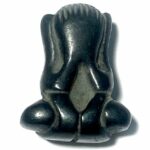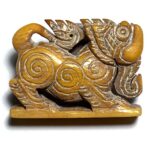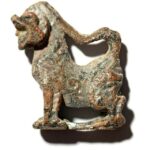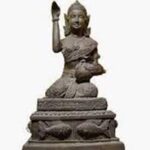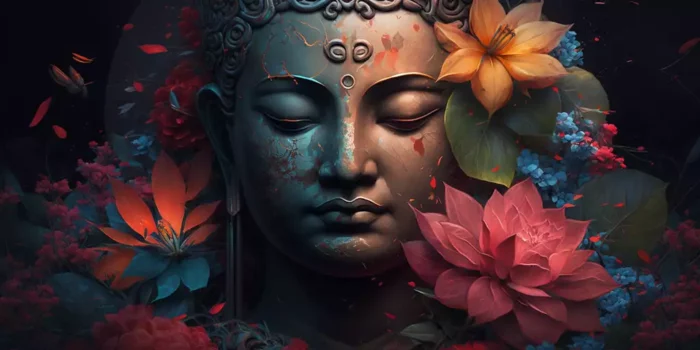
From Origins to Modern Times: Tracing the Evolution and Global Influence of Thai Buddhism
Buddhism is the dominant religion in Thailand, with approximately 95% of the population identifying as Buddhists. Thai Buddhism has its unique characteristics, incorporating elements of Theravada Buddhism, as well as local customs and beliefs. Thai Buddhism has its own history, key beliefs, practices, and rituals.

Sacred Ta-Khian Tree with Devotees Seeking Lottery Numbers from the Mae Nang Ta-Khian Tree Spirit
Historical Background
Buddhism was introduced to Thailand (formerly known as Siam) more than 2,000 years ago. The first recorded contact with Buddhism in Thailand was during the reign of Emperor Ashoka of India, who sent Buddhist missionaries to various parts of Southeast Asia, including Thailand. Over the centuries, Buddhism became an integral part of Thai culture and society, influencing art, literature, politics, and philosophy.
Key Beliefs
Like other forms of Buddhism, Thai Buddhism is based on the Four Noble Truths and the Eightfold Path. The Four Noble Truths are the foundation of Buddhist teachings and emphasize the nature of suffering and the path to liberation. The Eightfold Path is a set of ethical and mental guidelines that Buddhists follow to achieve enlightenment.
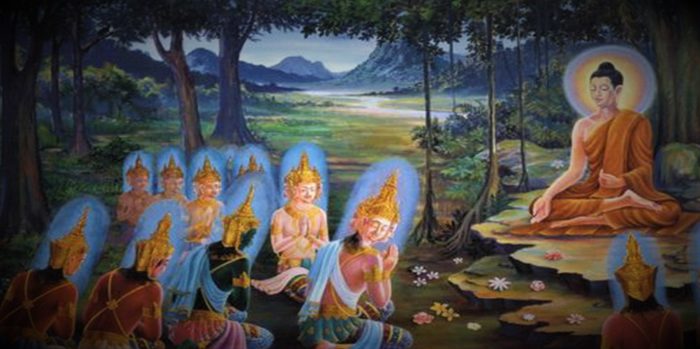
Thai Buddhism, however, has some unique beliefs that distinguish it from other forms of Buddhism. One of the key beliefs is the concept of merit (บุญ), which is the accumulation of good deeds through acts of generosity, morality, and meditation. Merit is believed to bring good fortune, blessings, and happiness in this life and the next.
Another key belief in Thai Buddhism is the concept of karma (กรรม), which is the law of cause and effect. Buddhists believe that one’s actions in this life will determine one’s future existence and that good deeds will lead to a better rebirth while bad deeds will lead to a worse one.
Practices and Rituals
Thai Buddhism incorporates a wide range of practices and rituals that reflect the country’s unique cultural and religious heritage. Some of the most common practices and rituals include:
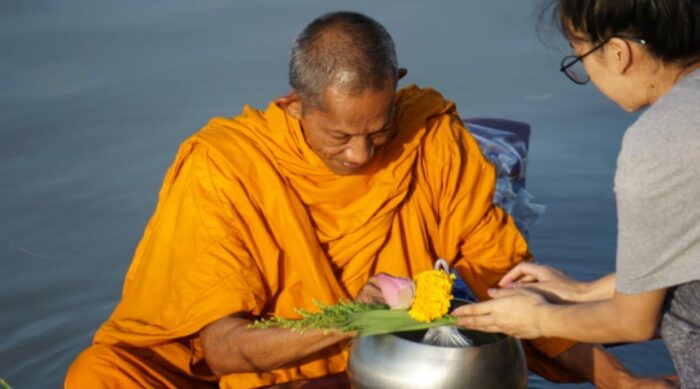
- Offering food to monks: Monks are highly respected in Thai society, and offering food to them is a way to gain merit and show respect. Monks go on daily alms rounds to receive food from laypeople.
- Making merit: Making merit is an important practice in Thai Buddhism, and it involves performing good deeds such as giving donations to temples or helping those in need.
- Chanting: Chanting is an integral part of Thai Buddhist practice and is often done in Pali, the language of the Buddhist scriptures. Chanting is believed to bring about inner peace, focus, and concentration.
- Meditation: Meditation is a central practice in Buddhism, and Thai Buddhists practice various forms of meditation to develop mindfulness, concentration, and insight.
- Festivals and ceremonies: Thai Buddhism has several festivals and ceremonies throughout the year, including Songkran (Thai New Year), Loy Krathong (Festival of Lights), and Visakha Bucha Day (Buddha’s Birthday).
Monasticism
Monasticism is an essential aspect of Thai Buddhism, and monks play a significant role in Thai society. Monks are highly respected and revered and are seen as spiritual leaders and teachers. They live according to strict rules and guidelines, including celibacy, poverty, and detachment from worldly pleasures.
Becoming a monk is a significant milestone in Thai Buddhist culture, and many young men enter the monastery for a short period of time as a rite of passage. The process of becoming a monk involves several steps, including ordination and taking vows.
The Emergence and Spread of the Thai Forest Tradition: A Study of the Dhammayut Lineage and Ajahn Chah’s Influence on the Development of Western Buddhism
The Dhammayut Order is a subsect of Theravada Buddhism that was founded in Thailand in the late 19th century. It was established by King Mongkut, who had spent many years as a monk before ascending to the throne. The Dhammayut Order emphasizes strict adherence to monastic rules and a focus on meditation and study of the Pali scriptures.
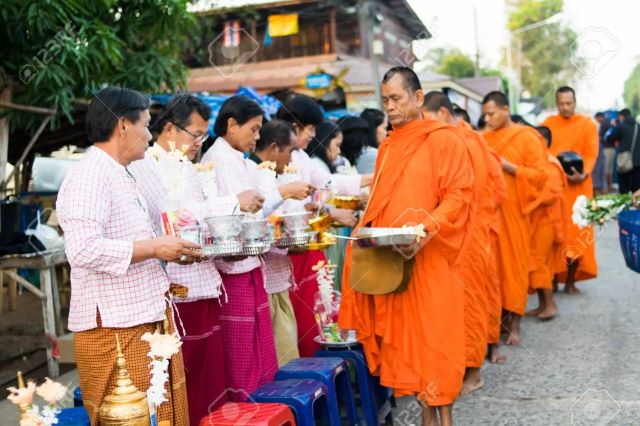
In the early 20th century, two forest monks, Ajahn Sao and Ajahn Mun, began a revival of the forest tradition in Thailand. They emphasized intensive meditation practice in remote forest locations and strict adherence to the monastic rules. This movement became known as the Thai Forest Tradition and attracted many young men to ordain as monks and practice intensive meditation.
One of the most influential figures in the Thai Forest Tradition was Ajahn Chah, who trained under Ajahn Mun and went on to establish a network of monasteries throughout Thailand. Ajahn Chah became renowned for his simple and direct teaching style, and his emphasis on mindfulness in daily life. He also welcomed Westerners into the monastic community, which was unusual at the time, and many Westerners were drawn to his teaching and practice.
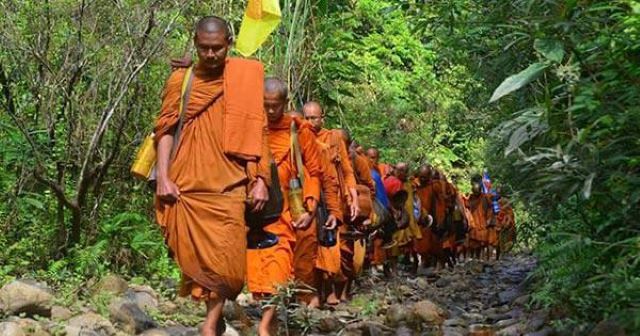
Ajahn Chah’s influence led to the Thai Forest Tradition becoming popular with foreigners, and many Westerners began to ordain as monks or nuns in Thailand. This led to the establishment of many branch monasteries throughout the world, including in the United States, Europe, and Australia.
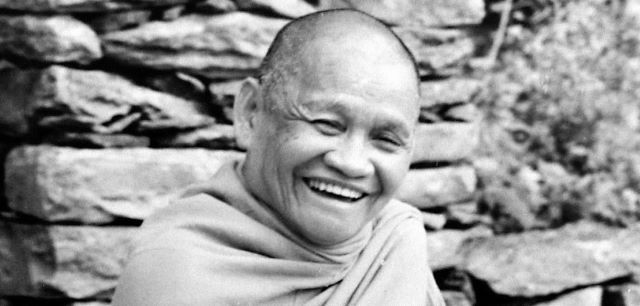
Today, the Thai Forest Tradition is one of the most popular forms of Theravada Buddhism in the West, with many Westerners drawn to its emphasis on meditation, mindfulness, and strict adherence to the monastic rules. The tradition has spread all over the world, with branch monasteries in many countries, and has had a significant impact on the development of Buddhism in the West.
Thai Forest Tradition: An Overview
The Thai Forest Tradition, also known as Kammatthana Tradition, is a branch of Theravada Buddhism that emerged in Thailand in the early 20th century. It is known for its emphasis on meditation, forest monasticism, and strict adherence to the Vinaya, the monastic code of conduct.

History and Origins
The Thai Forest Tradition has its roots in the ancient tradition of forest monasticism, which dates back to the time of the Buddha. Forest monasticism involves monks living and meditating in remote forests away from the distractions of civilization. This tradition was passed down through the centuries, and by the early 20th century, it had become less prominent in Thailand, where monks had become increasingly attached to their monasteries and communities.
In the early 20th century, a movement emerged in Thailand, to revive the tradition of forest monasticism. This movement was led by two monks, Ajahn Sao and Ajahn Mun, who sought to return to the strict ascetic practices of the early forest monks. They believed that the strict discipline and rigorous training of the forest monastic lifestyle were essential for achieving spiritual liberation.
The teachings of Ajahn Sao and Ajahn Mun emphasized the practice of mindfulness and insight meditation, which involves observing one’s thoughts and sensations without judgment, and developing a deep understanding of the nature of reality. They also placed great emphasis on the importance of living in accordance with the Vinaya, the monastic code of conduct that governs the behavior of Buddhist monks.
Expansion and Influence
The Thai Forest Tradition gained popularity in Thailand and beyond due to the influence of the Great Ajahn Chah, a disciple of Ajahn Mun, who helped to spread the teachings of the tradition to a wider audience. Ajahn Chah founded many monasteries in Thailand, and his teachings attracted many Westerners who were interested in Buddhism.
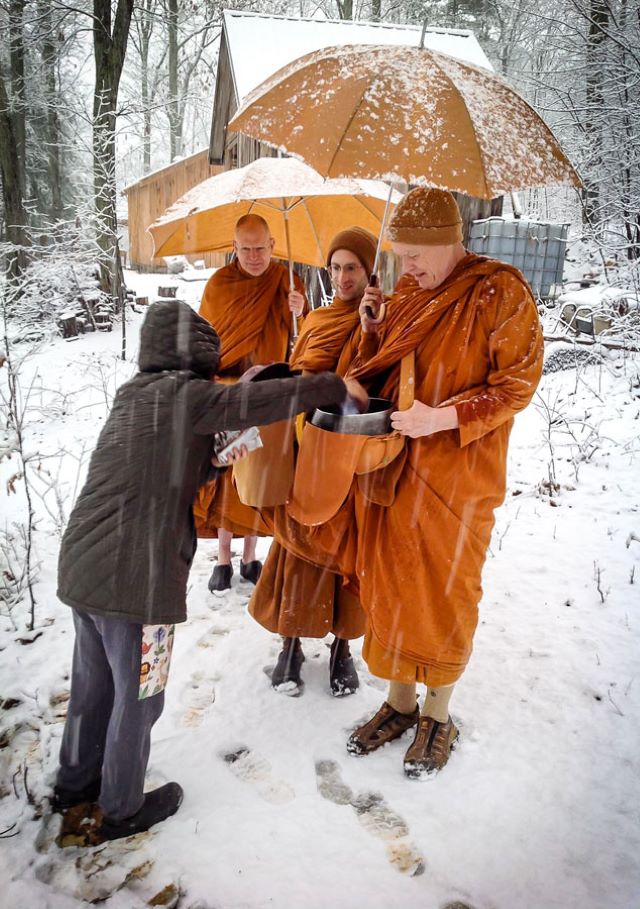
Ajahn Chah’s teachings emphasized the importance of meditation and mindfulness in daily life, and his simple, direct style of teaching resonated with many Westerners. His teachings inspired a new generation of Western monks and nuns who ordained in Thailand and brought the teachings of the Thai Forest Tradition to the West.
Today, the Thai Forest Tradition has a worldwide following, with branch monasteries and meditation centers in many countries. The tradition continues to emphasize the importance of meditation and mindfulness, and the strict adherence to the Vinaya remains a cornerstone of the practice.
Teachings and Practices
The Thai Forest Tradition places great emphasis on the practice of meditation, which is seen as the key to developing mindfulness, concentration, and insight. Meditation is practiced in a variety of forms, including sitting, walking, and standing meditation.
In addition to meditation, the Thai Forest Tradition places great importance on the cultivation of moral virtue, which is seen as a necessary foundation for spiritual practice. The Vinaya, the monastic code of conduct, is seen as a guide for behavior that is in accordance with Buddhist principles.
The Thai Forest Tradition also emphasizes the importance of living in harmony with nature, and many forest monasteries are located in remote areas, away from the distractions of civilization. Monks and nuns are encouraged to live simply, with few possessions and minimal comforts.
Conclusion
The Thai Forest Tradition is a unique branch of Theravada Buddhism that emphasizes the importance of meditation, mindfulness, and strict adherence to the Vinaya. Its emphasis on forest monasticism and living in harmony with nature reflects its deep roots in the ancient tradition of Buddhist monasticism.
The teachings of the Thai Forest Tradition have inspired many people around the world to embark on a path of spiritual practice and self-discovery. The tradition continues to attract new followers and has played an important role in the development of modern Buddhism.
For General Folk, most Thai Buddhists however have a mixed belief system, and have strong beliefs in the occult, and in Buddhist Amulets and Occult Magic Charms. Amulets (พระเครื่อง – Phra Khrueang) are a widespread and significant aspect of Thai Buddhism. Here’s a breakdown of their use and significance:
What are Amulets?
Typically small Buddha images, representations of monks, deities, or geometric symbols, and animist images,, or taklismanic objects, made from various materials like metal, precious stones, clay, or even incense ash. Some amulets are made from sacred powders, metals, clay, carved materials such as wood, or ivory or stone, and the pantheon of amulets found in existence wiuthin Thai Buddhist Culture, is too numerous to count or document in any single volume of any size. Thai Buddhist amulets are often inscribed with sacred Khom (Khmer Sanksrit) mantras (Kata), or symbols believed to bring blessings.
Why are Amulets Used?
Thai amulets are believed to provide protection from harm, misfortune, and evil spiritss, and are een as bringing good luck, prosperity, and success in various aspects of life (health, wealth, love). Amulets serve as a source of comfort and inspiration for the wearer.
How are Amulets Used?
Worn on necklaces, bracelets, or tucked into clothing pouches close to the body. Some amulets are blessed by monks during ceremonies, enhancing their perceived power, and even Lay Practitioners also create Buddhist and Occult amulets. Respectful treatment of amulets is expected, such as avoiding stepping over them or keeping them in unclean places, or breaking the 5 Precepts in the case of purely Buddhist Amulets. Not all Thai Buddhists wear amulets, and some may have different beliefs about their effectiveness. The use of amulets can be seen as a way to connect with Buddhist teachings and practices. There is a significant collector culture surrounding ancient amulets, with some considered valuable antiques. The concept of amulets has roots in pre-Buddhist animistic beliefs in Thailand. Different amulets are believed to offer specific types of protection or blessings. The reverence for amulets reflects the deep faith and cultural significance of Buddhism in Thailand.



